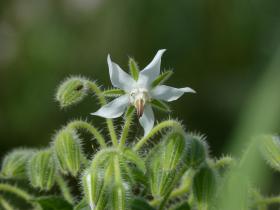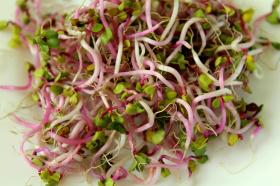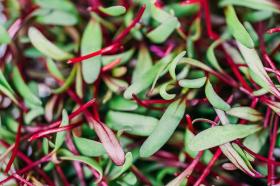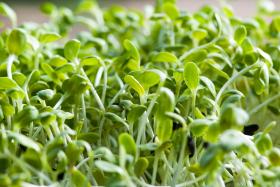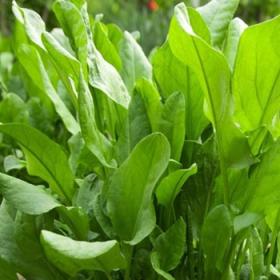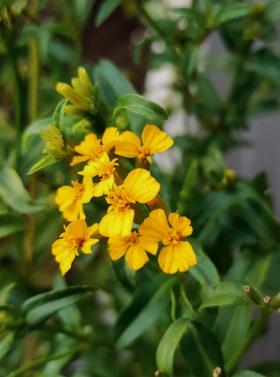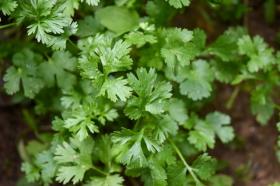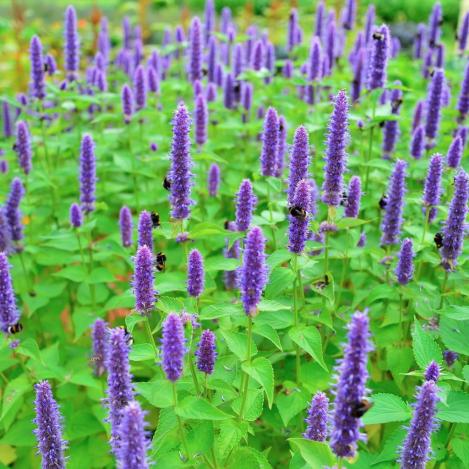
Used in Ayurveda KOREAN MINT, regular seeds - not treated and non-gmo
Agastache rugosa
Gives a mint like flavour but with much more spice.Agastache rugosa, commonly called Korean-mint or purple giant hyssop, is an aromatic herb in the mint family.General Information (in English)
Botanical name: Agastache rugosa
Common names: Korean mint, wrinkled giant hyssop, Korean anise hyssop
Family: Lamiaceae (Mint family)
Origin: East Asia (Korea, China, Japan)
Type: Perennial aromatic herb and ornamental plant
Height: 60–100 cm
Flowers: Spikes of purple to bluish-purple blooms with sweet anise aroma
Leaves: Toothed edges, fragrant – anise/licorice scent
Growing Tips
Sunlight: Full sun to partial shade
Soil: Well-drained, moderately fertile
Sowing: Start indoors in early spring or sow outdoors in May
Spacing: 30–40 cm
Hardiness: Down to –20 °C (USDA zone 5)
Pollinator-friendly: Attracts bees, butterflies, and beneficial insects
Low maintenance: Ideal for herb gardens, wildflower borders
Uses & Interesting Facts
Tea & Culinary Herb
– Leaves and flowers make a soothing, digestive tea
– Flavor is anise-like, with hints of licorice
– Used in Korean cuisine (called baechohyang)Traditional Medicine
– Used in Korean and Chinese medicine for indigestion, nausea, and colds
– Believed to have anti-inflammatory and antimicrobial propertiesPollinator Plant & Ornamental
– Excellent nectar plant for bees and butterflies
– Long-blooming and visually strikingEdible Leaves & Flowers
– Used in salads, drinks, desserts, or candied for decoration
– Unique, refreshing tasteNatural Air Freshener & Potted Plant
– Strong aroma makes it great for freshening up indoor air
– Can be grown in containers on balconies or windowsills
Like other members of its family such as basil, peppermint, sage, Korean mint is also aromatic, and medicinally useful. The plant is native to moist grasslands, valleys and stream banks in East Asia (China, Japan, Korea, Russian Primorye, Taiwan, India, and Vietnam). Blue Licorice, Chinese Patchouli, wrinkled giant hyssop, purple giant hyssop, Indian mint, huo xiang, Chinese giant-hyssop, Korean-mint, Korean licorice mint and patchouli herb are few of the popular common names of the plant. Genus name comes from the Greek words agan meaning very much and stachys meaning an ear of wheat in reference to the numerous flower spikes tightly packed with whorls of brightly colored violet flowers. Specific epithet means wrinkled.
Plant description
Korean Mint is an upright, clump-forming, herbaceous perennial plant that grows about 40–100 cm (16–39 in) tall. The plant is found growing in grassy places in mountains, especially by streams, and in valleys. The plant does best in dry, well-drained soil, and prefers soil rich in organic matter, and neutral ph. Oval-cordate leaves are oppositely arranged, 5–10 cm (2–4 in) long and 3–7 cm (1 1⁄4–2 3⁄4 in) broad, with coarsely serrated margins. Some leaves have hair and/or touches of white on the underside.
Flower and fruits
Purple bilabiate flowers bloom in verticillasters that are 5–15 cm (2–6 in) long and 2 cm (3⁄4 in) broad. The calyx is 5–6 mm (0.20–0.24 in) long, with five narrow triangular lobes. Petals are 8–10 mm (0.31–0.39 in) long, lower ones longer and the ones inside serrated. The stamens are didynamous, long, and exposed. Flowering normally takes place from July to September. Fertile flowers are followed by schizocarp, with obovate elliptical mericaps of 1.8 mm (0.071 in).
Health benefits of Korean mint
Korean mint gets its health benefits from the various nutritious compounds it contains. Listed below are few of the popular health benefits of Korean Mint
1. Cures diarrhea
Decoction of Korean Mint leaves and dried tangerine peel is taken to treat acute gastroenteritis accompanied with vomiting and diarrhea. A mixture of soapstone, agastache rugosa and clove are pounded into powdered for oral taking to treat vomiting and diarrhea due to pathogenic summer heat-damp.
2. Miscarriage Prevention
Powdered Korean Mint, nut grass root and licorice root is taken with salt water to prevent miscarriage.
Traditional uses and benefits of Korean Mint
- Korean mint is commonly used in Chinese herbalism, where it is considered to be one of the 50 fundamental herbs.
- Considered to be a “warming” herb, it is used in situations where there is “dampness” within the digestive system, resulting in poor digestion and reduced vitality.
- Leaves and stems are antibacterial, anti-fungal, aromatic, carminative, diaphoretic, febrifuge and stomachic.
- They are used internally to improve the appetite and strengthen the digestive system; they relieve symptoms such as abdominal bloating, indigestion, nausea and vomiting.
- They are also used to treat morning sickness.
- Leaves are also used in the treatment of chest congestion, diarrhea and headaches.
- An infusion of the leaves is used in the treatment of angina pains.
- Plant is used as a folk remedy for cancer, extracts of the plant have shown anticancer activity.
- It was traditionally used to relieve nausea, vomiting and poor appetite.
- Korean Mint is said to relieve nausea, and vomiting, and cure fungal infections.
- It is pungent (acrid), and slightly warm, and works on spleen, stomach, and lung.
- Essential oil is used against fever, headache, stomach pain, morning sickness, and gastrointestinal disorders.
- Tea is warming in nature, and helps in chest congestion, diarrhea, and headache, dampness within the digestive system, poor appetite, and digestion, morning sickness, abdominal bloating, indigestion, nausea, vomiting, and other digestive problems.
- Tea is considered antibacterial, antifungal, aromatic, carminative, diaphoretic, febrifuge, and stomachic.
- Decoction of Korean Mint is used as a mouth wash to treat bad breath.
Ayurvedic Health benefits of Korean Mint
- Wrinkles: Take 1/4th cup each of Witch Hazel and Comfrey. Put 2 tablespoon of Patchouli essential oil. Apply on the affected area with Cotton balls.
- Age spot: Take 2 tablespoon Frankincense Oil, 2 tablespoon Common Juniper Oil, 2 tablespoon Rosemary, 2 tablespoon Patchouli Oil, 2 tablespoon Rose, 2 tablespoon Orange Oil, 2 tablespoon Lavender Oil, 2 tablespoon Chamomile Oil and 2 tablespoon Almond Oil. Mix all oils. Heat for 10 minutes. Cool. Store in a bottle. Massage it over age spots for 5 minutes daily. It removes age spots effectively.
- Age Spot: Take 10 gram Rosewood Oil, 10 gram Myrrh Oil, 10 gram Chamomile Oil, 10 gram Orange Oil, 10 gram Mandarin Orange Oil, 10 gram Patchouli Oil and 10 gram Sage Oil. Put all ingredients in a vessel. Heat for 5 minutes. Store in a glass bottle. Massage over affected area with this preparation for 10 minutes.
- Baldness: Take 20 gram Olive Oil, 20 gram Almond Oil, 20 gram Jojoba Oil, 10 gram Tea Tree Oil, 10 gram Thyme Oil, 10 gram Patchouli Oil, 20 gram Rosemary Oil and 20 gram Spikenard Oil. Put all oils in a glass bottle. Cover. Leave it for a week. After a week, massage your scalp with this preparation twice a week. It is an effective formula to cure hair problems.
Culinary uses
- Young leaves can be consumed raw or cooked.
- Strong anise-like fragrance, they are normally used as a flavoring or as an addition to the salad bowl.
- Leaves can be used as a tea substitute.
- Seed is possibly edible.
- Leaves can be dried, and sprinkled on salad to add flavor.
- Leaves are used as a substitute for French tarragon or brewed into a tea, and the flowers mixed in mesclun salads.
Source: healthbenefitstimes
Packet 150 seeds


